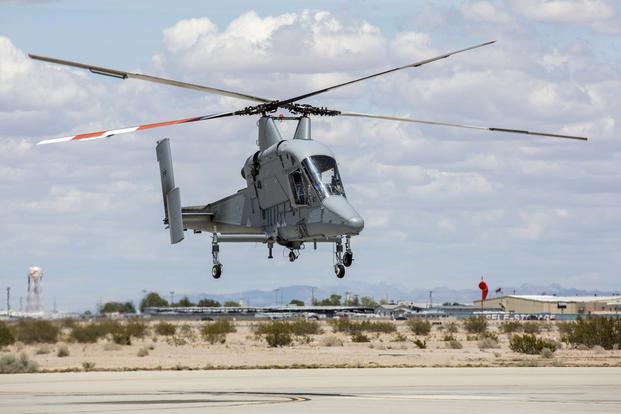The Marine Corps plans to upgrade its two K-MAX unmanned cargo helicopters to improve the service's ability to autonomously deliver gear to forward-positioned grunts.
The Corps first deployed the K-MAX unmanned cargo delivery helicopters to Afghanistan in 2011, using the experimental systems -- developed by Lockheed Martin and Kaman Aerospace -- to carry tons of supplies to troops. The aircraft were put in storage after they redeployed from Afghanistan in 2014, but were pulled out and sent to Yuma, Arizona to help with cargo transportation in 2016.
Lt. Gen. Steven Rudder, deputy commandant for Marine Corps Aviation, on Wednesday told members of the Senate Armed Services Committee's subcommittee on seapower that the service will continue to expand upon the K-MAX concept.
"We are trucking them back to Connecticut to have them retrofitted to get them back flying again," he said, answering a question from Sen. Joni Ernst, R-Iowa, about the service's efforts to use autonomy in the future of aviation. "We are having them retrofitted with some systems that will make them autonomous. We hope to get them back next year, and that will allow us to go back and experiment more with autonomous systems."
The K-MAX is capable of carrying up to 6,000 pounds of cargo at a time, making it a logistics "workhorse," Rudder said. "We are hoping that this research project will really help us get into the autonomous part of that particular system."
In addition to K-MAX, the Corps is exploring other autonomous systems, such as its Marine Air-Ground Task Force Unmanned Expeditionary System, or MUX, a ship-launched sea drone, he said.
"We would like to have that be an autonomous, early warning electronic warfare type of asset that has long-loiter persistence time that does the job of what an E-2D [Advanced Hawkeye] would do off the carrier. But it does that from the amphibious ready group," Rudder said.
James Geurts, assistant secretary of the Navy for research, development and acquisition, told Ernst that his service wants to develop a single, common data link to talk to anything unmanned "so we don't get into the situation where we have to have 10 different data links."
"When we talk about 'where we are going forward,' it is to open up our ability to take whatever comes -- so that vehicle, whatever it looks like, is discovered, invented by whomever -- we can quickly integrate it into the weapon system," Geurts said.
-- Matthew Cox can be reached at matthew.cox@military.com.













